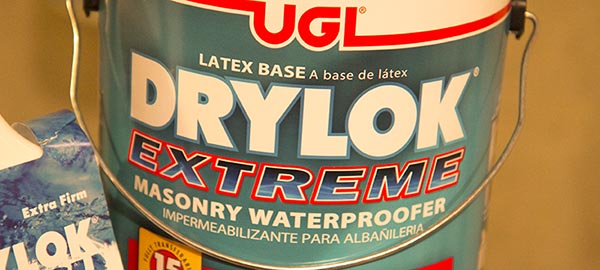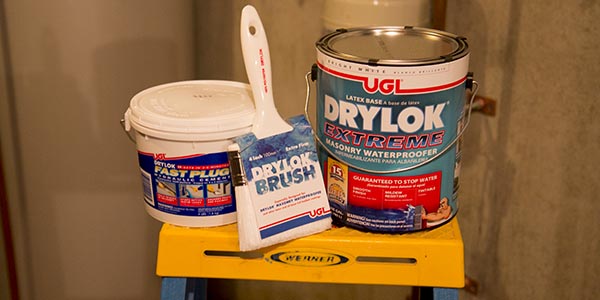DRYLOK® EXTREME – Keep Your Basement Dry


DRYLOK® Extreme Masonry Waterproofer
Keeping a basement dry is a challenge even under the best of circumstances. I’ve written many articles on how to insulate them properly to prevent mold and mildew issues. Another consideration for keeping basements dry is preventing water vapor that’s trapped inside the foundation walls from migrating into the basement. Water vapor migration from the foundation wall can drastically increase the humidity levels and create an environment ripe for mold and mildew to grow.


DRYLOK® Extreme Features
- Ready mixed – Low-odor Formula
- Withstands 15 pounds of hydrostatic pressure, greater than a wall of water 33 feet high
- Breathable film – does not trap moisture in masonry
- 15-year Warranty
- Clean up with soap and water
- Applies easily with brush and/or roller
- Smooth / Bright White Finish
- Passes ASTM D-7088 Resistance to Hydrostatic Pressure and ASTM D-6904 Resistance to Wind Driven Rain.
- Tintable – available in white




One of the most important steps in any paint (coatings) project is surface preparation. Before applying the DRYLOK® Extreme Masonry Waterproofer on the foundation wall I thoroughly cleaned the concrete wall to remove dust, dirt and spider webs! I used a stiff broom to sweep off the bulk of the material from the wall and finished with my shop vacuum to ensure a clean starting surface.
Most concrete / masonry surfaces are quite porous and rough. So I highly recommend using a very stiff brush to apply DRYLOK® Extreme. I actually used brushes that DRYLOK sells which worked very well. The stiff brush allows you to easily apply the sealer and get it into all the pores. Your average concrete foundation wall may look quite smooth from a distance, but the minute you start applying any type of paint or sealer you’ll quickly realize there are many pores to fill.
I’m very happy with the results of the DRYLOK® Extreme Masonry Waterproofer. Now my mechanical room is definitely brighter (my plumber and electrician will appreciate that!) and the wall certainly has a robust line of defense against potentially damaging moisture in this room. This is absolutely a project any DIY’er can tackle and get excellent results. Keeping your basement dry will go a long way towards protecting your home from mold, mildew and poor air quality.
Priced at my local Home Depot for $32.98 per gallon, it’s an affordable solution that’s similar in price to good quality paint. So if you’re looking to dry out that basement, spruce up a laundry room, or brighten your man cave this is a product that will certainly help that effort.
Recent Posts
Framing Stick Nailer vs Coil Nailer
Which is Better a Stick Nailer or Coil Nailer? Framers have many choices in nailers…
How Many Roofing Nails Per Square of Shingles
Estimating How Many Nails for a New Roof When it comes to estimating materials for…
Composite / PVC Decking – Layout Tips & Advice
Composite / PVC Decking Layout Tips and Advice Composite and PVC decking have really changed…
Benefits of an ERV System (Energy Recovery Ventilator)
Benefits of ERV Systems (Energy Recovery Ventilator) If you're building a new home or doing…
Vermiculite Attic Insulation Abatement
Vermiculite Attic Insulation If your home was built before 1990 there is a chance it…
Nuisance Tripping of AFCI (Arc Fault) Circuit Breakers
Arc Fault (AFCI) Circuit Breakers Tripping Often An arc-fault circuit interrupter (AFCI) or arc-fault detection…
View Comments
I've had this (or something similar) on my list for quite a while. Would this be effective in controlling moisture for cinderblock garage walls? Our outside-facing garage walls are up against raised beds which bring in water when there is a heavy rain.
It will help....but it's not perfect....you need to stop the water from the outside if you really want to fix it correctly.
Thank you. That's on "the list." In your opinion/experience, will wate seepage from rain (live in the Northeast) cause the drylok to deteriorate or break down? If so, will adding a fresh coat repair the affected area?
Not sure it will deteriorate...the problem is you're trying to stop water pressure from the inside....think of it like this...if there was a small hole in the Hoover Dam....would you plug it from the exposed face? no...the pressure would be too high. Same principal applies here.
Can I glue the 8x4 foam panels to it before I build my stud walls the way you gules them on one of your other videos?
yes
Should the basement walls be painted with the drylok prior to installing the 4 X 8 sheets of the foam board or is that unnecessary? Three of the walls in my basement have never had any wet spots on the concrete block ever so I was hoping to skip painting them. The remaining wall was wet a few times due to an improper grade and shrub bed along the house and clogged gutter and these have all been corrected. It seems like this one wall could have the potential to be damp and I do plan on painting that wall.
Mike - I seldom do it, but it also doesn't hurt. Belt and suspenders :)
Todd-I have a few different issues going on in my crawlspace. It's a 1928 granite rock exterior house and has open holed cinder block interior walls in the crawlspace. The HVAC system and water heater are located in there. Water heater is wrapped in insulation but all the duct work is not insulated. It's got 2 outside vents and the ducts produce a lot of condensation. The walls also have condensation on them. I also have no ground vapor barrier. I inherited this house from my Grandmother and I don't think she realized what was lacking. There was no door to the crawlspace, just a board leaning against it. I built and framed in a door, which helped seal it a little better. I've already installed gutters and attached drains to the downspouts to move water away from foundation. The East wall was getting water inside the crawlspace, so I dug down to the footer and installed Black Jack tar on the outside wall and a 6 mil poly under a perforated drain line, wrapped in material with gravel. I had 2 truck loads of dirt brought in to slope dirt away from house to help with drainage. My question is, where do I begin? I thought if I first wrap insulation around duct (not sure which kind of insulation) as the humidity is high, then see if it dries out at all. Not sure if capillary suction is causing walls to weep or it's the HVAC. Any thoughts would be greatly appreciated. Sorry such a long read. I wanted you to give you all the information I had.
Carl - Definitely need to get that duct work insulated and sealed properly. Most of the foil covered duct insulation should be fine for that, before installing it I'd use mastic to seal all the joints really well. You're definitely going to want to seal that dirt floor as well.
Todd, I am a little confused. One of the product features is "Breathable film – does not trap moisture in masonry" Does this mean that it won't stop water vapor migration?